Telangiectatic osteosarcoma
Images
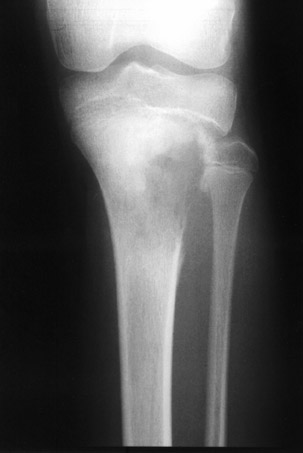
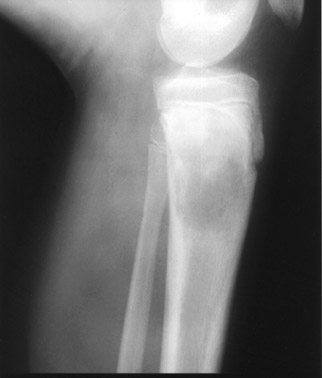

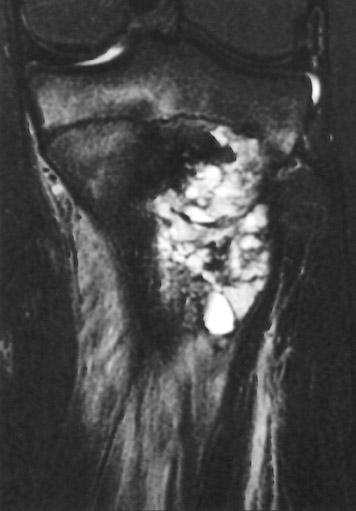
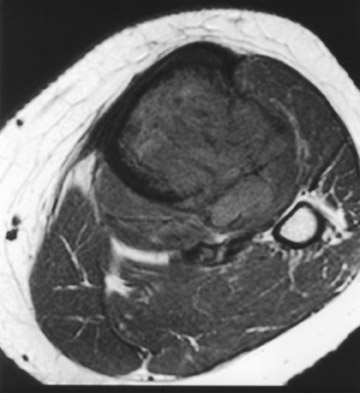
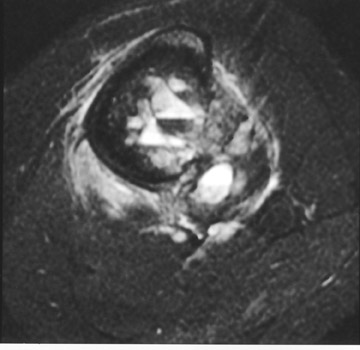
Prepared by Scott D. Kendell, MD and Mark S. Collins, MD , Department of Radiology, Mayo Clinic, Rochester, MN. Dr. Kendell is now at Duke University Medical Center, Durham, NC.
Case summary
A previously healthy 11-year old girl with a 4-month history of intermittent, but progressive, left knee pain presented to our institution. The physical examination revealed slight fullness of the proximal left lower extremity compared with the right. A complete blood count and basic metabolic panel were normal. Anterioposterior and lateral radiographs of the left knee were performed (Figure 1) followed by magnetic resonance imaging (MRI) of the left knee (Figure 2).
Diagnosis
Telangiectatic osteosarcoma
Imaging findings
Anteroposterior and lateral radiographs of the left knee revealed a predominantly lytic, permeative lesion in the proximal tibial metaphysis with a wide zone of transition and cortical destruction along the lateral margin of the lesion (Figure 1).
Selected T1- and T2-weighted coronal and axial MR images of the proximal left tibia revealed a 5-cm mass located eccentrically within the lateral aspect of the proximal tibial metaphysis (Figure 2). The mass contained multiple fluid-fluid levels. There was cortical disruption along the posterolateral aspect of the proximal tibia with extension of the mass into the adjacent soft tissues.
Discussion
Telangiectatic osteosarcoma is a rare malignant osteogenic tumor. Paget 1 first described a case of telangiectatic osteosarcoma in 1854, but it was Ewing, 2 in 1922, who formally classified the tumor as a distinct histologic subtype of osteosarcoma.
In a large series of bone tumors at the Mayo Clinic, telangiectatic osteosarcoma represented 3.5% of all osteosarcomas and 0.7% of all malignant bone tumors. 3 The tumor is seen slightly more often in males (3:2 male:female ratio) and occurs most frequently in the second decade of life, but can be seen over a large age range. 4 Similar to conventional osteosarcoma, the majority of lesions are metaphyseal and located around the knee (distal femur, proximal tibia). The pelvis, scapula, ribs, and skull are less common locations for telangiectatic osteosarco- 3-5 There are reports of telangiectatic osteosarcoma as a secondary tumor in Paget's disease 5,6 and a case of telangiectatic dedifferentiation of a parosteal osteosarcoma. 7 One case of multicentric telangiectatic osteosarcoma has also been reported. 8 Telangiectatic osteosarcoma can rarely occur as an extraskeletal tumor. 4,5
Conventional radiographs of patients with telangiectatic osteosarcoma typically reveal a lucent lesion with a wide zone of transition. Aggressive radio-graphic features, such as periosteal reaction, cortical destruction, pathologic fracture, and soft-tissue mass are also common findings. Consistent with the cystic nature of the tumor, the computed tomographic (CT) attenuation of the central portion of the lesion can be lower than that of soft tissue, and bone scintigraphy often shows increased radiotracer uptake peripherally in the tumor with central photopenia (known as the donut sign). 5 Fluid-fluid levels are often seen on CT and magnetic resonance imaging (MRI), but these are not entirely specific for telangiectatic osteosarcoma. 5,9,10 Hemorrhage is frequently observed in association with the tumor as high signal intensity on T1- and T2-weighted images. 5,11
Differential considerations for telangiectatic osteosarcoma during the radiographic evaluation include aneurysmal bone cyst, giant cell tumor, Ewing's sarcoma, angiosarcoma, and solitary bone cyst. Murphey et al 5 have reported that when subtle osteoid formation is seen in the peripheral portion of the tumor on CT or when enhancement with intravenous contrast is seen on CT or MRI in the same region, telangiectatic osteosarcoma can be differentiated from aneurysmal bone cyst, which is the lesion most often confused with telangiectatic osteosarcoma.
The prognosis for telangiectatic osteosarcoma was previously thought to be poor. In 1976, Matsuno et al 12 reported on 25 patients at the Mayo Clinic and found that 24 of those patients were dead within 8.5 years. Mervak et al 13 updated the Mayo Clinic experience in 1991 and reported that the prognosis for telangiectatic osteosarcoma was not significantly different from conventional osteosarcoma. 3 Other studies have also concluded that the 5-year survival for patients with telangiectatic osteosarcoma is the same as that for patients with conventional osteosarcoma. 14,15
Treatment of telangiectatic osteosarcoma consists of chemotherapy followed by wide surgical resection, similar to that of conventional osteosarcoma. 14,15
Conclusion
Telangiectatic osteosarcoma is a rare malignant bone tumor. The location, prognosis, and treatment of this unusual lesion mirror that of conventional osteosarcoma. Fluid-fluid levels and areas of hemorrhage are typically seen on MRI along with aggressive radiographic features, such as periosteal reaction, wide zone of transition, cortical destruction, and soft-tissue mass.